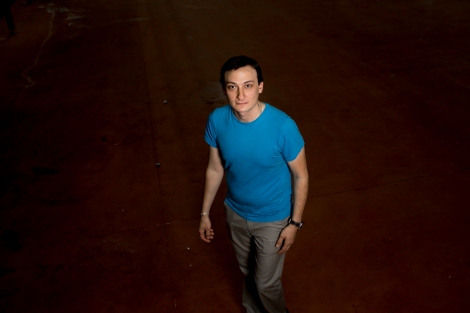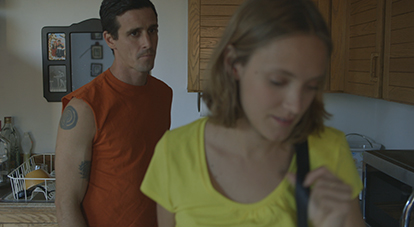
Frank V. Ross is an actor, editor, and filmmaker based in Chicago. In 2012, his sixth film as star, writer, director, and producer, Tiger Tail in Blue, was nominated for the “Best Film Not Playing at a Theater Near You” prize at the Gotham Awards. His most recent feature, Bloomin Mud Shuffle, stars James Ransone, Alexia Rasmussen, Natasha Lyonne, Alex Karpovsky, and David Pasquesi. It is also nominated in the “Best Film Not Playing at a Theater Near You” category for 2015, and will have multiple screenings at the MoMA in New York City beginning Dec. 11, 2015. Frank V. Ross spoke with Sean Malin of C.M. Film Commentary about shooting the film in his hometown of Westmont, casting up-and-coming industry stars by e-mail, and screening Bloomin Mud Shuffle for new audiences. This interview has been transcribed, edited, and compressed from audio for publication.
Editor’s Note: Mr. Ross’s films, beginning with the 2005 feature Quietly on By, can be seen on demand here, through Fandor. Tickets to Bloomin Mud Shuffle at the Museum of Modern Art are available here.
*****
Sean Malin: Your new movie had its World Premiere at the Wisconsin Film Festival earlier this year. No disrespect intended whatsoever, but I’ve never been there myself, nor have I spoken to any filmmakers whose films premiered there. Knowing that two of your films as director have had premieres at SXSW, and you were in others [like Drinking Buddies, dir. Joe Swanberg, 2013] that were at the festival, I suspect that premiering Bloomin Mud Shuffle in Madison was no accident for you. Why did you choose to debut it there?
Frank V. Ross: It’s funny you ask because a programmer at the Chicago International Film Festival just asked me why I didn’t premiere it here, in my home city. I told him we were looking for a big market to see it, which is true, but it wasn’t so much of a decision at first. We had finished cutting the movie a while ago and were sending it out to certain festivals, and after a few letters of rejection we went back and recut it. Thank god we did that because we almost put out a movie that had the wrong ending – it didn’t look like the finished film, with the final shot we have now. So then another cycle of festival submissions rolled around, and we started putting it out to smaller regional festivals. The first ones to take it were these two really talented programmers, Jim Healy and Mike King, at Wisconsin. And here’s a little-known fact: The Color Wheel [dir. Ross Perry, 2011] had its premiere there, too.
SM: Your film shares a producer with Alex Ross Perry’s new movie, Queen of Earth: Joe Swanberg. I feel like through you or Joe, I could get a message to any filmmaker in a major city in America.
FVR: Probably, but I’ve actually never met Alex. I’m so excited to see Queen of Earth, though. And we definitely know a lot of the same people. I edited two movies his cinematographer, Sean Price Williams, shot. They’re best friends with Robert Greene [who edited Queen], another filmmaker that I met in Columbia, Missouri; and his movie, Actress [2013], is at the top of my Netflix queue.
SM: These people live in Brooklyn, and there’s a whole different world there, a contingent of collaborators probably in the range of fifty people. Richard Brody knows them better than I do, but he lives in New York and I’m in Austin. You live and work in Chicago – so does that interfere in any way or create some insurmountable bridge between you and those filmmakers?
FVR: Well, I don’t have to be dealt with by a lot of them, if that’s what you mean *Laughs*. No, it’s not a problem, and I have friends in New York that I do work with. It’s just the other ones who get all their new films distributed that I don’t always see.
SM: I know you’re teasing, but it’s the very fact of Tiger Tail being called the “Best Film Not In a Theater Near You” that brought your work to my attention. Now all your films are on Fandor and it’s a different story – people can seek out and watch your movies. But distribution’s been an issue for some of your films. Are things getting better in that regard?
FVR: It is definitely getting better. I think things have always been getting better.


SM: Bloomin Mud Shuffle has Hollywood actors like Ransone, Lyonne, Karpovsky, et cetera. That must help.
FVR: I don’t think that has much to do with the quality of the movies, though. When I was nineteen or twenty, I used to hang festival rejection letters around my office, so much so that it began to look at a little psychopathic. One day, a friend of mine came into the office and said, “It’s time to take all that shit down,” and I didn’t have to think about it, he was right.
SM: Because you’d “made” it, in terms of your work?
FVR: Moreso that it’s important to move on because I can’t figure out what it “must be” that’s [earning] rejection letters. If I thought any more about why I was getting rejection letters, I’d probably try to change the kind of movies I make, wouldn’t I?
SM: Your films make me feel extremely good and emotionally rich, they’re “thinkers” films, and I say that with the utmost sincerity. But certainly there are idiosyncrasies in the work, especially in dialogue between your characters, that can be hard to fully get. Parts of Mud Shuffle and Audrey the Trainwreck go right over my head during conversations, they’re just so specific.
FVR: Right. There’s this scene in Bloomin Mud Shuffle where Alex [Karpovsky’s] character is telling the boss guy about his new house, and the boss responds, “What school district?” Alex’s character responds, “Ninety-nine”, but Alex kept thinking about it afterwards, and he actually asked me, “Would I really know that – the school district of my new house?” I immediately said, “Yes. They tell you a thousand times. Everybody knows what school district your house is in when you buy a house.” It’s important to me to try to lock that sort of detail in.

SM: That’s so fascinating. There’s a microbial authenticity to it.
FVR: It is hard not to [be authentic] at times. Like when you’re shooting in an open bar in Chicago, with the poker machines on and people who don’t care that you’re there just think you’re in their way. It becomes very hard to sound full-of-shitt-y in front of people who are listening and saying things. But shooting in an open bar can also be a good test balloon of whether or not your dialogue sucks.
SM: *Laughs* Of course, because you have the people in the bar going, “No, no, no, that’s not going to work for me, it just doesn’t sound right.” There’s no getting past them.
FVR: What you want to hear is “Oh, I couldn’t even tell you guys were shooting. I thought you were just talking.” That is how dialogue is supposed to sound, and that has happened to me a lot. I keep my writing in that realm most of the time, but I’ve also been trying to write more “lines”, I guess you could say, than I have in the past.
SM: Ad-libbed dialogue is a major element of your films, as well as Swanberg’s, though I’m very aware of how thin the line between a tight script and an “improvised” film can be. Was Bloomin Mud Shuffle a tighter script-to-screen kind of work than you have made in the past?
FVR: I usually preach the rhetoric of, “Here’s the shape of the scene – don’t go off that, and you’ll be fine.” But to be honest, the [films] are all pretty tightly scripted. There’s virtually no improvisation in them; there’s ad-libbing, as you said, but not improv. I’ve always been pretty protective of that. Whenever I get asked that question at a Q & A for a film and there’s an actor with me, I just hand the actor the microphone because for me, it’s a stock answer.
SM: Speaking of shapes, the film has a particular one: it’s a circular narrative, of which I’ve seen very few. The opening sequence is also the one that sequentially ends the movie. The only recent movie like it that comes to mind is Inside Llewyn Davis [2013, dir. Joel and Ethan Coen].

FVR: I have been waiting for someone to bring this up for a long time. I had just finished editing Mud Shuffle when I watched Llewyn Davis. And at some point towards the end of it, I just went *shrugs shoulders* “Eh, great minds…” *Laughs*
SM: They aren’t exactly the same – yours continues after revisiting the opening scene, where James Ransone’s character brings a traffic sign into a bar.
FVR: That actually happened to me. A friend of mine took a traffic cone and brought it into that exact bar where we shot it. I went to high school with the bar owner’s daughter, too. Everyone in that area knows one another.

SM: What is it like to show go location scouting for a project in the area where you grew up? Do you already know where you want to shoot before you begin the scout process?
FVR: You have to write for what you think you can get, you know? I knew I could get the apartment [of Ransone’s character] because that was my friend’s apartment. I love that apartment, too, the way that it’s boxed in and the light in it. And right across the way, if you look out the window, what do you see? A brick wall! There’s so much brick in this film.
SM: Does the scouting process make you nostalgic? Like will you seek out places from your childhood in Chicago to put in your films?
FVR: Absolutely, though that isn’t in Chicago proper. The majority of Bloomin Mud Shuffle takes place on Cass Avenue, in Westmont, which is where I grew up. There’s a train station that I cross in Tiger Tail; that same station is the one where Alexia [Rasmussen’s character] is catching a train in Mud Shuffle. Then there’s the place in Audrey the Trainwreck where Anthony [J. Baker] takes all his dates.

SM: The coffee shop?
FVR: It doesn’t exist anymore but that place used to be on Cass Avenue. Basically, anyone who has seen my movies that goes to Cass Avenue will recognize the stores as places that have appeared in the movies. Shooting in those places makes me feel comfortable. I feel safe there. I don’t feel like I’m going to be harassed in any way, and even if I am, I know the person that’s doing the harassing, anyway. The locations in my movies are as close as I can get to where I actually lived. At this point, I shoot in those places because it is funny – you look at that train station and go, “How many movies has that train station been in?” The answer is “a lot of them” because I grew up three blocks from that station, hearing it from my house at night. Now I just gravitate towards trains.
SM: Watching your first couple of films, there’s a sense of intimacy and personality to those details that a lot of critics and viewers usually characterize as “small” or “humble” in some way, like that the story isn’t “general” to people. But now you’ve got those places being filled with famous actors like Ransone – this does not feel like a movie singularly about your love of trains.
FVR: I see what you’re saying.
SM: …and the film is touring festivals around the country, people who love Natasha Lyonne from Orange is the New Black and Karpovsky from Girls are going to hunt the movie down. It’s a big move from Audrey and Tiger Tail to Mud Shuffle. Do you get the impression that audiences are getting something different than they ever have from your work?
FVR: I do think that. I feel like they give a film more respect when they recognize the faces in it. I guess that is their “seal of approval.” But I didn’t put much thought into it when casting. The reason Natasha’s in the film is that she and [James] are thick-as-thieves. We sent her a different part originally, but she wanted to play Jock, and I was like, “Totally, she’s way better for that – way to cast yourself!” She showed up and turned out to be hilarious and awesome; she knows exactly what she’s doing. There’s a scene in the film where she just completely loses it, and she was able to do take after take after take of this scene to the point where I said, “What are you, some kind of machine?”
SM: Alex is also ubiquitous in independent films these days. How did you come to work with him?
FVR: I’ve known Karpovsky a long time, and we’ve wanted to work together for a while. I don’t remember who suggested casting him – I think Joe just e-mailed him the script, and said to me, “Karpovsky?” That was it for him. Also, Alex had made a documentary on T.J. [Jagodowski] and Dave [Pasquesi] called Trust Us, This Is All Made Up [2009], so he contacted them…there was really no proper casting session for any of the actors.
SM: A lot of these people are part of the Brooklyn/NYC indie contingent we talked about earlier, and you just showed the movie at the Rooftop Film Series in Brooklyn. The audience there tends to be very open-minded and hip and more interested in a high caliber of cinema than many festival-goers. How was the response there?
FVR: Honestly, it was a little embarrassing…
SM: Did you get a standing O? Be honest.
FVR: No, no, no. There were just a lot of people coming up to me after the screening saying very nice things, and me just responding, “Okay, cool down, cool down.” It all felt really good, but I wished they’d each given me ten bucks *Laughs*. Dan Nuxoll, the Rooftop progammer, sends me nice e-mails, and he’s really proud of how they’ve built that series. People can wander in and you get a good group from all over the city. I enjoyed showing it there.
SM: Where else will Bloomin Mud Shuffle get seen before it gets swept away in the glut of independent and mainstream films that rise up in the last half of the year?
FVR: We [screened] at a festival in Bend, Oregon on my birthday. And we also [screened] at the Sidewalk Film Festival, in Birmingham, Alabama, where Audrey actually won the Best Narrative Feature prize a few years ago – and I wasn’t there. But Joe was, and I remember he left me this voicemail where he said, “Hey man, it’s Joe and your movie just won the festival,” and then you just this loud screaming noise, and Joe saying, “Okay call me back soon.” I saved that voicemail for as long as I could.


Pingback: In Conversation With: Darius Clark Monroe at Sundance | CineMalin: Film Commentary and Criticism·
Pingback: Sundance 2017: Getting “TRUMPED” Makes for Electrifying Cinema | CineMalin: Film Commentary and Criticism·
Pingback: In Conversation With: Nathan Silver | CineMalin: Film Commentary and Criticism·